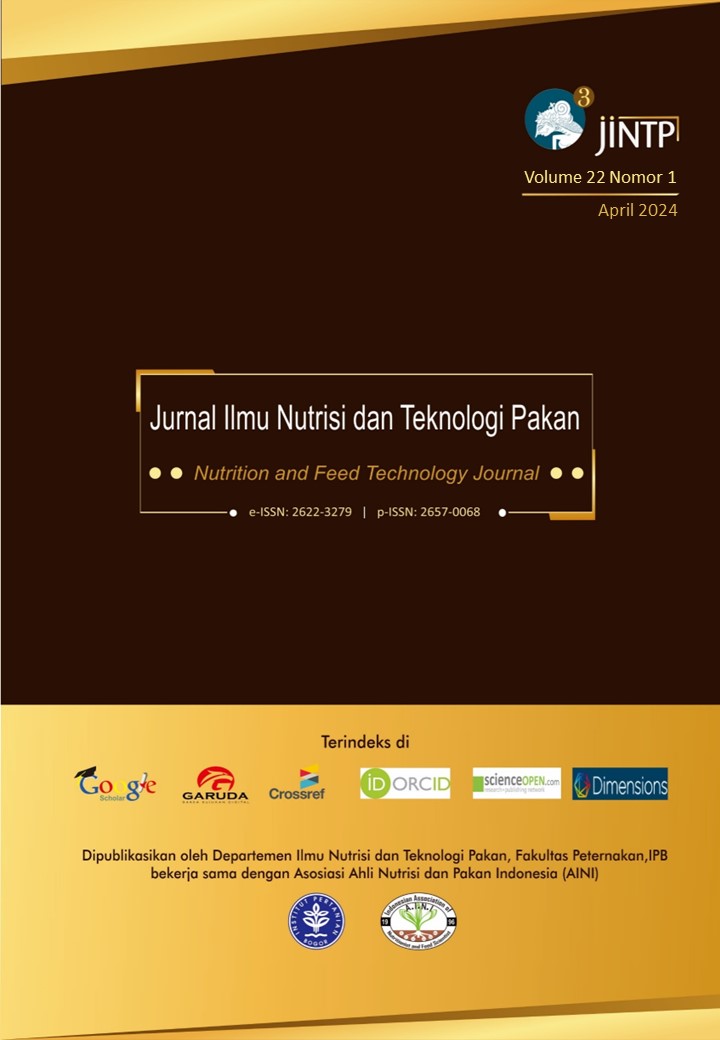Daya Simpan Probiotik Bakteri Asam Laktat asal Larva Black Soldier Fly Terenkapsulasi
Shelf-life of Encapsulated Lactic Acid Bacteria Probiotics from Black Soldier
Abstract
Lactic acid bacteria as probiotic candidates can be isolated from black soldier fly larvae. This study aimed to develop encapsulated lactic acid bacteria (LAB) probiotics from BSF larvae and to evaluate the effect of encapsulation on probiotic viability during 12 weeks of storage at room temperature and 4°C. The experimental design was a factorial completely randomized design with two treatments: storage temperature and storage
time. The variables observed are the number of cells and the level of cell resistance. The result showed that based on the growth curve of LAB isolates from BSF larvae, they could be harvested at 16 hours of age to be produced as probiotics. Encapsulated LAB probiotics from BSF larvae had a population of lactic acid bacteri (LAB) 107 CFU g-1 and were able to maintain the cell viability of 99.3%. Temperature and storage time
significantly affect (p<0.05) the viability of encapsulated LAB. It can be conclude that encapsulation was able to optimally maintain the LAB viability at temperature of 4°C for 4 weeks of storage.
Key words: black soldier fly larvae, encapsulation, probiotic, storability, viability
Downloads
References
Anggraeni JA, Nugraha FA & Suhardiman A. 2019. Aktivitas antibakteri dari mikroalga laut Porhyridium cruentum terhadap bakteri Staphylococcus epidermidis dan Propionibacterium acne. Jurnal AGROTEK. 6(2): 63-69.
Bilang M, Tahir M & Haedar D. 2018. Mempelajari viabilitas enkapsulasi sel probiotik Lactobacillus plantarum dan Streptococcus thermophilus pada es krim. Canrea Journal: Food Technology, Nutritions, and Culinary Journal. 1(1):41–52.
Burgain J, Gaiani C, Linder M & Scher J. 2011. Encapsulation of probiotic living cells: From laboratory scale to industrial applications. Journal of Food Engineering. 104(4):467–483.
Calinoiu L-F, Vodnar D-C & Precup G. 2016. A Review: The probiotic bacteria viability under different conditions. Bulletin of University of Agricultural Sciences and Veterinary Medicine Cluj-Napoca Food Science and Technology. 73(2):55.
Chantziaras I, Boyen F, Callens B, & Dewulf J. 2014. Correlation between veterinary antimicrobial use and antimicrobial resistance in food-producing animals: A report on seven countries. Journal of Antimicrobial Chemotherapy. 69(3):827–834.
Chotiah S & Damayanti R. 2018. Karakterisasi bakteri asam laktat kandidat probiotik untuk mengatasi salmonelosis pada ayam pedaging. Buletin Plasma Nutfah. 24(1): 89-96.
Duckett SK & Pratt SL. 2014. Anabolic implants and meat quality. Journal of Animal Science. 92:3–9.
Dumitru M, Vodnar DC, Elemer S, Ciurescu G, Habeanu M, Sorescu I, Georgescu SE & Dudu A. 2021. Evaluation of non-encapsulated and microencapsulated lactic acid bacteria. Applied Sciences (Switzerland). 11(21).
Ebrahimi A, Csonka LN, & Alam MA. 2018. Analyzing thermal stability of cell membrane of salmonella using time-multiplexed impedance sensing. Biophysical Journal. 114(3):609–618.
Eratte D, McKnight S, Gengenbach TR, Dowling K, Barrow CJ, & Adhikari BP. 2015. Co-encapsulation and characterization of omega-3 fatty acids and probiotic bacteria in whey protein isolate-gum Arabic complex coacervates. Journal of Functional Foods. 19:882–892.
FAO/WHO. 2002. Report of a join FAO/WHO working group on drafting guidelines for the evaluation of probiotics in food. London Ontario (CA): FAO.
Fijan S. 2014. Microorganisms with claimed probiotic properties: An overview of recent literature. International Journal of Environmental Research and Public Health. 11(5):4745–4767.
Hernández-Carranza P, López-Malo A & Jiménez-Munguía M-T. 2013. Microencapsulation quality and efficiency of Lactobacillus casei by spray drying using maltodextrin and vegetable extracts. Journal of Food Research. 3(1):61-69.
Humayun Kober AKM, Rajoka MSR, Mehwish HM, Villena J & Kitazawa H. 2022. Immunomodulation potential of probiotics: a novel strategy for improving livestock health, immunity, and productivity. Microorganisms. 10(2): 1-20.
Kementrian Pertanian Republik Indonesia. 2017. Peraturan Menteri Pertanian Republik Indonesia Nomor 14/PERMENTAN/PK.350/5/2017 tentang Klasifikasi Obat Hewan. Jakarta (ID): Kementrian Pertanian Republik Indonesia.
Krasaekoopt W, Bhandari B & Deeth H. 2003. Evaluation of encapsulation techniques of probiotics for yoghurt. International Dairy Journal.13:3-13.
Liu B, Wang C, Huasai S, Han A, Zhang J, He L, & Aorigele C. 2022. Compound probiotics improve the diarrhea rate and intestinal microbiota of newborn calves. Animals. 12(3):1-14.
Liu H, Cui SW, Chen M, li Y, Liang R, Xu F & Zhong F. 2019. Protective approaches and mechanisms of microencapsulation to the survival of probiotic bacteria during processing, storage and gastrointestinal digestion: A review. Critical Reviews in Food Science and Nutrition. 59(17):2863–2878.
Maier RM & Pepper IA. 2015. Bacterial growth. In IL Pepper, CP Gerba, TJ Gentry (Eds.), Environmental microbiology. San Diego (US): Academic Press. pp. 37-56
Nurhajati T, Soepranianondo K, & Lokapirnasari W. 2016. Uji aktivitas pertumbuhan enterobacter cloacae selulolitik aerob rumen-1 isolat asal limbah cairan rumen sapi peranakan ongole. Jurnal Veteriner. 17 (3):383–388.
Nuryana I, Andriani A, Lisdiyanti P & Yopi. 2019. Analysis of organic acids produced by lactic acid bacteria. Di dalam: IOP Conference Series: Earth and Environmental Science. 251: 012054.
Parthasarathi S & Anandharamakrishnan C. 2016. Enhancement of oral bioavailability of vitamin E by spray-freeze drying of whey protein microcapsules. Food and Bioproducts Processing. 100: 469–476.
Peredo AG, Beristain CI, Pascual LA, Azuara E & Jimenez M. 2016. The effect of prebiotics on the viability of encapsulated probiotic bacteria. LWT - Food Science and Technology. 73:191–196.
Pangestu RF, Legowo AM, Al-Baarri AN, & Pramono YB. 2017. Aktivitas antioksidan, pH, viskositas, viabilitas bakteri asam laktat (BAL) pada yoghurt powder daun kopi dengan jumlah karagenan yang berbeda. Jurnal Aplikasi Teknologi Pangan. 6 (2):78–84.
Rascón MP, Huerta-Vera K, Pascual-Pineda LA, Contreras-Oliva A, Flores-Andrade E, Castillo-Morales M, Bonilla E, & González-Morales I. 2018. Osmotic dehydration assisted impregnation of Lactobacillus rhamnosus in banana and effect of water activity on the storage stability of probiotic in the freeze-dried product. LWT - Food Science and Technology. 92:490–496.
Republik Indonesia. 2014. Undang-Undang Nomor 41 Tahun 2014 tentang Peternakan dan Kesehatan Hewan. Jakarta (ID): Sekretariat Negara.
Respati NY, Yulianti E, & Rakhmawati A. 2017. Optimasi suhu dan pH media pertumbuhan bakteri pelarut fosfat dari isolat bakteri termofilik. Jurnal Prodi Biologi. 6 (7).423-430.
Silaban BJS, Nurhayati L & Hartanti AW. 2020. Viabilitas probiotik Lactobacillus acidophilus DLBSD102 setelah mikroenkapsulasi. Jurnal Sains Natural. 10 (1):6.
Sumanti DM, Lanti I, Hanidah I-I, Sukarminah E, & Giovanni A. 2016. Pengaruh konsentrasi susu skim dan maltodekstrin sebagai penyalut terhadap viabilitas dan karakteristik mikroenkapsulasi suspensi bakteri Lactobacillus plantarum menggunakan metode freeze drying. Jurnal Penelitian Pangan. 1 (1): 7-13.
Uthami FN & Irdawati I. 2024. Karakteristik pola pertumbuhan bakteri termofilik isolat MS-12 dari sumber air padas mudiak sapan. MASALIQ. 4 (1):344–351.
Wahyuningsih N, & Zulaika E. 2019. Perbandingan pertumbuhan bakteri selulolitik pada media nutrient broth dan carboxy methyl cellulose. Jurnal Sains dan Seni ITS. 7(2):36–38.
Wardhana AH. 2017. Black Soldier Fly (Hermetia illucens) as an alternative protein source for animal feed. Indonesian Bulletin of Animal and Veterinary Sciences. 26 (2):069.
Yang R, Xie Y, Lombardo SP, & Tang J. 2021. Oil protects bacteria from humid heat in thermal processing. Food Control. 123:107690.
Yun O, Zeng XA, Brennan CS, & Han Z. 2016. Effect of pulsed electric field on membrane lipids and oxidative injury of Salmonella typhimurium. International Journal of Molecular Sciences. 17 (8):1-13.
Zheng L, Crippen TL, Holmes L, Singh B, Pimsler ML, Benbow ME, Tarone AM, Dowd S, Yu Z, & Vanlaerhoven SL. 2013. Bacteria mediate oviposition by the black soldier fly, Hermetia illucens (L.),(Diptera: Stratiomyidae). Scientific Reports. 3(1): 1-8.
Copyright (c) 2024 D M Fassah, A Hairani, A Meryandini, D A Astuti, I K G Wiryawan

This work is licensed under a Creative Commons Attribution 4.0 International License.
The authors of the submitted manuscript have to understand and agree that the copyrights published are held by Jurnal Ilmu Nutrisi dan Teknologi Pakan. Copyrights includes rights in reproducing, distributing and selling every section of articles in all forms and media. The copyright transfer form is signed by the corresponding author. The author”
• Creative Commons Attribution (CC BY)
you are allowed to:
Share – copy and redistribute the material in any medium or format
Adapt – remix, transform, and build upon the material
for any purpose, even commercially.
The licensor cannot revoke these freedoms as long as you follow the license terms.
Jurnal Ilmu Nutrisi dan Teknologi Pakan (Nutrition and Feed Technology Journal)

This work is licensed under a Creative Commons Attribution 4.0 International License.












